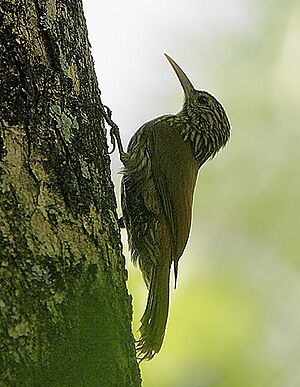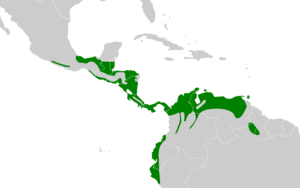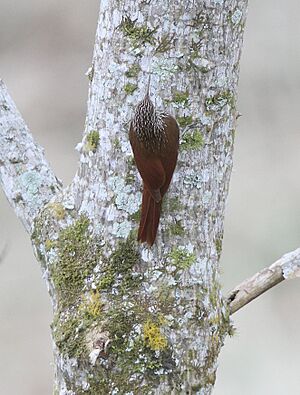Streak-headed woodcreeper facts for kids
Quick facts for kids Streak-headed woodcreeper |
|
|---|---|
 |
|
| Conservation status | |
| Scientific classification | |
| Genus: |
Lepidocolaptes
|
| Species: |
souleyetii
|
 |
|
The streak-headed woodcreeper (Lepidocolaptes souleyetii) is a type of passerine bird. It belongs to the ovenbird family called Furnariidae. You can find this bird in many places, including Mexico, Central America, Brazil, Colombia, Ecuador, Guyana, Peru, Venezuela, and on the island of Trinidad.
Contents
About the Streak-headed Woodcreeper
What's in a Name?
Scientists group living things into categories. This helps them understand how different species are related. The streak-headed woodcreeper has seven different types, called subspecies. They are:
- L. s. guerrerensis
- L. s. compressus
- L. s. lineaticeps
- L. s. littoralis
- L. s. uaireni
- L. s. esmeraldae
- L. s. souleyetii
The second part of the bird's scientific name, souleyetii, honors a French zoologist and naval doctor named Louis François Auguste Souleyet.
How to Spot a Streak-headed Woodcreeper
This bird is about 19 to 21 centimeters (7.5 to 8.3 inches) long. It weighs between 23 and 31 grams (0.8 to 1.1 ounces). It's a slender, medium-sized bird with a long, thin, curved beak. Male and female streak-headed woodcreepers look very similar.
The most common type, L. s. souleyetii, has a face with thin, pale streaks. Its neck also has streaks. It has a pale stripe above its eye and a ring around its eye. The top of its head and back of its neck are dark brown with bold, pale streaks. These streaks often go down to its upper back.
Its back and wing feathers are a mix of reddish-brown and olive. Its flight feathers, rump, and tail are a cinnamon-red color. The throat is pale, and the belly is grayish-olive with pale streaks that have dark edges. The streaks are wider on its chest and sides. Its eyes are brown, and its beak is pale brown with a bluish-pink lower part. Its legs and feet are grayish-green. Young birds look much like adults, but they have small dark spots instead of streaks on their undersides.
Other subspecies have slight differences. For example, some have narrower streaks or darker colors. Some might be smaller or have a darker upper beak.
Where Do They Live?
The streak-headed woodcreeper lives in many different places. Each subspecies is found in a specific area:
- L. s. guerrerensis lives in parts of Mexico.
- L. s. compressus is found from southern Mexico through Central America to western Panama.
- L. s. lineaticeps lives from Panama into northern and eastern Colombia and western Venezuela.
- L. s. littoralis is found on Trinidad, in parts of northeastern Colombia, central Venezuela, Guyana, and northern Brazil.
- L. s. uaireni lives in southeastern Venezuela.
- L. s. esmeraldae is found from southwestern Colombia south into Ecuador.
- L. s. souleyetii lives from southwestern Ecuador into northwestern Peru.
These birds like many types of wooded areas. They prefer places that are somewhat open, like forests where leaves fall off trees in certain seasons. They also live in gallery forest (forests along rivers), new forests growing back, and even plantations. You can sometimes find them at the edges of humid forests or in open areas with scattered trees. They can also live in mangrove swamps and dry scrublands. They live at different heights above sea level depending on the country, usually below 1,800 meters (5,900 feet).
Woodcreeper Behavior
Staying Put
The streak-headed woodcreeper does not migrate. It stays in the same area all year long.
What Do They Eat?
This bird mainly eats small creatures without backbones, like insects and spiders. They also eat small fruits sometimes. They usually look for food alone or in pairs. They climb up tree trunks and branches, searching for food at all levels of the forest. They don't usually join large groups of different bird species when they hunt for food. They find their prey by peeling off bark or poking into cracks and moss on trees.
Reproduction and Life Cycle
Streak-headed woodcreepers form pairs during the breeding season. Outside of this time, they are usually on their own. The breeding season changes depending on where they live. For example, it's in June and July in Mexico, but April to October in Colombia.
They typically build their nests inside holes in trees. These holes might be natural or made by woodpeckers. They line the bottom of the nest with wood chips and pieces of bark. Sometimes, they even use nest boxes. Nests in trees are usually 3 to 25 meters (10 to 82 feet) above the ground.
A female woodcreeper usually lays two eggs. The parents take turns sitting on the eggs for about 15 days until they hatch. Both parents also help feed the baby birds.
Their Song and Calls
The song of the streak-headed woodcreeper is described as a "simple, clear trill" that goes down in pitch. It sounds soft and musical. Some people say it's a "high-pitched, thin, flat trill" that quickly goes down. Others describe it as a "loud, ringing, rapid, descending series of puttering notes."
Their calls include a "harsher, more rattling, shorter trill" and a soft, sad "pyuu." They also make a loud, quickly shaking call that goes down in pitch.
Conservation Status
The IUCN (International Union for Conservation of Nature) has looked at the streak-headed woodcreeper. They have decided it is a species of "Least Concern." This means they are not worried about it becoming endangered soon.
This bird lives in a very large area. Scientists estimate there are at least 500,000 adult birds, though this number might be getting smaller. No major threats have been found for this species. It is common in most places where it lives, though less common in higher areas. It can live in new forests that are growing back, at the edges of forests, and in open areas. Because it can live in places changed by humans, it is less affected by human activity than some other woodcreepers.



